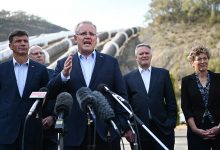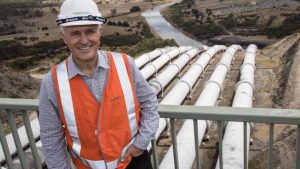Snowy 2.0 is again making headlines with more delays, tunnelling problems and cost increases. So, on the eve of the sixth anniversary of its announcement in March 2017, let’s have a quick recap.
The vision for this “nation-building” pumped-hydro battery was for it to be built in four years, for $2 billion, with no taxpayer support. It was to generate renewable energy and bring down electricity prices, while incurring minimal damage to Kosciuszko National Park.
None of those lofty aspirations has turned out to be anywhere near true. During the ensuing six years the news keeps getting worse and worse, with Snowy 2.0 setting many unenviable records and fast becoming one of Australia’s most spectacular infrastructure debacles.
Record one: underestimated completion time – four years to 12-plus
When announced, Snowy 2.0 was to be built in four years (that is, by 2021), unbelievably fast for such a large, complex project. Since then the completion date has been extended numerous times, with last month’s deferment from 2026 to December 2027 still looking optimistic.
Completion this decade is now unlikely. While it is rare these days for infrastructure projects to be completed on time, underestimating by a factor of three is unprecedented. And every year’s delay adds hundreds of millions of dollars to the cost and forgone revenue.
Record two: slowest tunnel boring machines – 200m in a year
Snowy 2.0’s three tunnel boring machines are excavating about 33km of tunnels. There has been scant mention of problems but it has recently been discovered that boring rates are far below specification and tunnelling is two years behind schedule. The covert record-setter is TBM Florence, having bored just 200m of the 17km headrace tunnel since her commissioning last March. For the past two months she has been “temporarily paused” (Snowy Hydro’s terminology) under a sinkhole she created, with no indication of when she will be un-paused. It is now starkly evident that Florence has been paused for most of her boring life. At this rate she will take 70 years to finish the tunnel.
Record three: underestimated cost – $2bn to up to $20bn
Snowy 2.0’s $2bn estimate increased to $3.8bn-$4.5bn in the business case, to $5.1bn for the main contract (only), to $5.9bn now. It is important to note these estimates don’t include all project costs, such as capitalised interest and suppressed dividends during construction, hedging, exploratory and other works, design, project management, and trans-mission. Also, the allowance for contingencies would have been exceeded by $2.2bn of contractor claims, with more to come. The final cost of Snowy 2.0’s main works is likely to exceed $10bn.
Then there’s a further $9bn-plus for 1000km of 500kV transmission connections to Sydney and Melbourne (Sydney Ring South, HumeLink and VIC/NSW interconnector), primarily for Snowy 2.0’s pumping and generation. Snowy Hydro initially estimated $1bn to $2bn. If Snowy Hydro is not compelled to contribute its fair share of the cost, arguably the majority, NSW electricity consumers will face a doubling of transmission tariffs.
An all-up cost for Snowy 2.0 approaching $20bn represents a tenfold increase, surely a record for cost underestimation.
Record four: underestimated subsidies – $0 to $1.4bn, with more to come
Despite repeated assurances that taxpayer support was not needed, the government was pressed to shore up Snowy 2.0’s business case with a $1.4bn equity injection, though this was insufficient to stop Snowy Hydro’s credit rating being downgraded two years ago from A- to BBB+. Then in December S&P Global Ratings revised Snowy Hydro’s credit outlook to “negative”, with “a high likelihood of (further) extraordinary government support” needed in the next 12-24 months, due to Snowy 2.0 (and Hunter gas station) delays and cost escalations, and an anticipated halving of earnings.
Record five: increasing electricity prices
Far from bringing electricity prices down as claimed, Snowy Hydro’s own modelling predicts prices will rise because of Snowy 2.0. And this is before accounting for transmission tariffs doubling.
Record six: inducing the NSW government to grant exemptions from environmental legislation
The claim that Snowy 2.0 will incur minimal impact on Kosciuszko National Park is demonstrably false. Vast construction sites across 30km of the park have been cleared, blasted, excavated, reshaped and compacted.
Hundreds of kilometres of roads and tracks are being constructed/ widened, and 20 million tonnes of excavated spoil will be dumped (when the TBMs get boring). But it’s the NSW government’s granting of exemptions from statutory protections that sets a record for environmental vandalism.
Snowy 2.0 has been exempted from the statewide ban on transferring noxious pests between waterways. This condones the movement of invasive Redfin perch, among other declared pests, from Talbingo Reservoir to Tantangara Reservoir and then across the alps into the Murray, Snowy, Murrumbidgee and Tumut headwaters, overwhelming native species and devastating trout fishing.
Also, Snowy 2.0 has been exempted from the obligation in the Kosciuszko Plan of Management for any additional transmission to be located underground. Four 330kV transmission lines on two sets of 70-metre towers will traverse 8km of the park over a cleared easement swathe up to 140m wide.
This will be the first time transmission lines are erected in a NSW national park for 50 years.
Misrepresentation: Snowy 2.0 is not a renewable generator, just an inefficient battery
Snowy 2.0 is not a renewable hydro generator that converts rainfall stored at elevation to electricity.
It is no more than a battery, and as such will be a net load on the National Electricity Market. And Snowy 2.0 will be a wasteful battery, consuming about 1.5 kilowatt-hours for pumping for each 1.0 kilowatt-hour it delivers, due to losses in the pumping/generation cycle and for transmission (two ways).
What should be done?
Snowy 2.0 never stacked up economically, technically or environmentally, and its gargantuan cost and environmental impacts cannot be justified for providing occasional long-duration storage. It will never pay for itself.
There are better alternatives.
The Australian government, Snowy Hydro’s shareholder on behalf of all Australians, must commission a comprehensive independent review, as experts have been urging for years.
Unfortunately, a few billion dollars have already been sunk, including the public’s $1.4bn, but many more billions are yet to be committed. Construction is bogged down in the early stages and the transmission connections have yet to be approved – it will be next decade before completion.
The current government did not approve this debacle but it will be held accountable if it fails to intervene.
Ted Woodley is former managing director of PowerNet, GasNet, EnergyAustralia, GrainCorp and China Light & Power Systems (Hong Kong).
This article was originally published in The Australian newspaper. Republished with permission.







